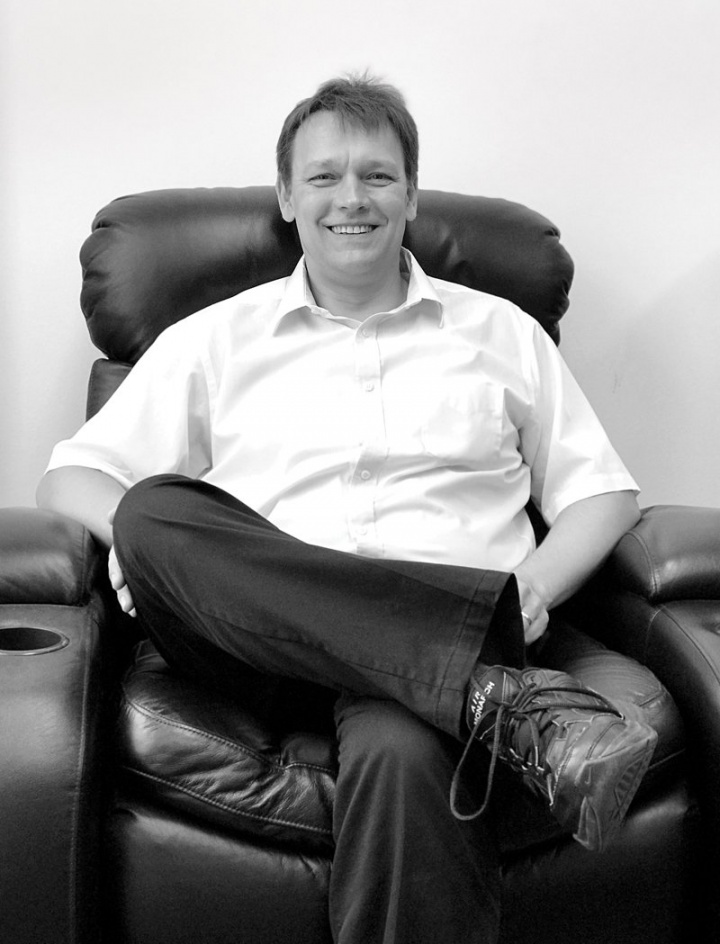Szabolcs Márka, the Walter O. LeCroy, Jr. Professor of Physics, believes strongly that creativity is a critical component of science research.
Columbia College | Columbia University in the City of New York
Szabolcs Márka, the Walter O. LeCroy, Jr. Professor of Physics, believes strongly that creativity is a critical component of science research.
In Szabolcs Márka’s office in Pupin there are three large recliners, surrounding a blackboard full of notes. No desk. When I raised an eyebrow at the unusual furnishings, Márka was unfazed: “You can be more creative when you’re comfortable — plus there are no desks between minds,” he says with a shrug.

JILL SHOMER
Márka, the Walter O. LeCroy, Jr. Professor of Physics, believes strongly that creativity is a critical component of science research — “a witches’ brew of thinking,” he calls it — and his approach to his work borders on literary. “Real science is a quest,” he says. “It’s a fire burning in you. You have to have a dream, you have to have difficulty and you have to have the unknown — if there’s no unknown, there’s no risk. You believe in yourself and just go for it.”
Márka’s work at Columbia is multidisciplinary: In addition to doing research and teaching undergraduate courses like “Physics for Poets” and the popular “Weapons of Mass Destruction” in the physics department, he is an astrophysicist, and is also passionate about the field of biophysics. He has collaborated with students from CUMC and the Mailman School of Public Health, has worked with the Zuckerman Institute and is a member of the Integrated Animal Behavior Center. Márka enjoys the differences in culture, expertise and viewpoints that these multi-department collaborations provide: “Creativity comes from a diverse set of ideas from diverse teams,” he says.
In 2009, five years after joining the Columbia faculty, Márka made headlines for his biophysics work with mosquitos, developing an idea that would prevent the spread of malaria by creating a “light shield” through which airborne insects will not fly. Márka and his team — which included his wife, Zsuzsa, a research scientist in the Columbia Astrophysics Laboratory — received funding from Bill Gates’ foundation (“now that guy is a visionary”) and were featured in The New York Times Magazine as an “Idea of the Year.”
Potentially saving communities from insect-borne illness has immediate, tangible benefits, which can be unusual in physics. “I’m not going to die in binary black holes,” he says. “Can I do something that makes a difference? The idea was good, but not as good as the reality — it changed my life.”
It was not Márka’s first life changer. He is a longtime member of the Laser Interferometer Gravitational-Wave Observatory (LIGO) team, which made history in 2015 with the first-ever direct detection of gravitational waves. The observation was hailed as one of the most important in the world, confirming Einstein’s general theory of relativity and marking a new era in astronomical exploration. Márka continues to innovate in LIGO at Columbia: “The department is a wonderful place to do science,” he says. “We support each other. Whatever I want to know, there’s an expert who is my colleague.”
Márka first found support for his scientific quests growing up in a small town in Hungary, where both of his parents were teachers. He was always fascinated by astronomy and physics; when he was 12 he built a Newtonian telescope from scratch. After a year of mandatory military service, he got his diploma in nuclear physics (the Hungarian equivalent of a master’s) from Lajos Kossuth University in 1993. Seeking growth and freedom, he pursued his doctorate in the United States and earned a Ph.D. in particle physics from Vanderbilt in 1999.
“Columbia is a wonderful place to do science. We support each other.
Whatever I want to know, there’s an expert who is my colleague.”
Márka says he’s happy to return the privilege of support by passing it on to his students. Shaping the next generation of scientists and communicating the beauty of physics — even to non-physicists — is his favorite part of teaching. “It’s good for you,” he says. “The world becomes more open; it’s very empowering.”
And again, Márka thrives in an environment of creative problem solving. “Faculty is responsible for the preservation of knowledge, the communication of knowledge and the advancement of knowledge,” he says. “Each person has a mixture of those abilities and desires, and in an academic community you have all these differences in these strengths. The important thing is that the whole is capable. And that’s something Columbia excels in — creating that space to freely create and for all departments to interact. That’s the future; that is Science.”

Published three times a year by Columbia College for alumni, students, faculty, parents and friends.
Columbia Alumni Center
622 W. 113th St., MC 4530, 6th Fl.
New York, NY 10025
212-851-7852
cct@columbia.edu

Columbia Alumni Center
622 W. 113th St., MC 4530, 4th Fl.
New York, NY 10025
212-851-7488
ccalumni@columbia.edu